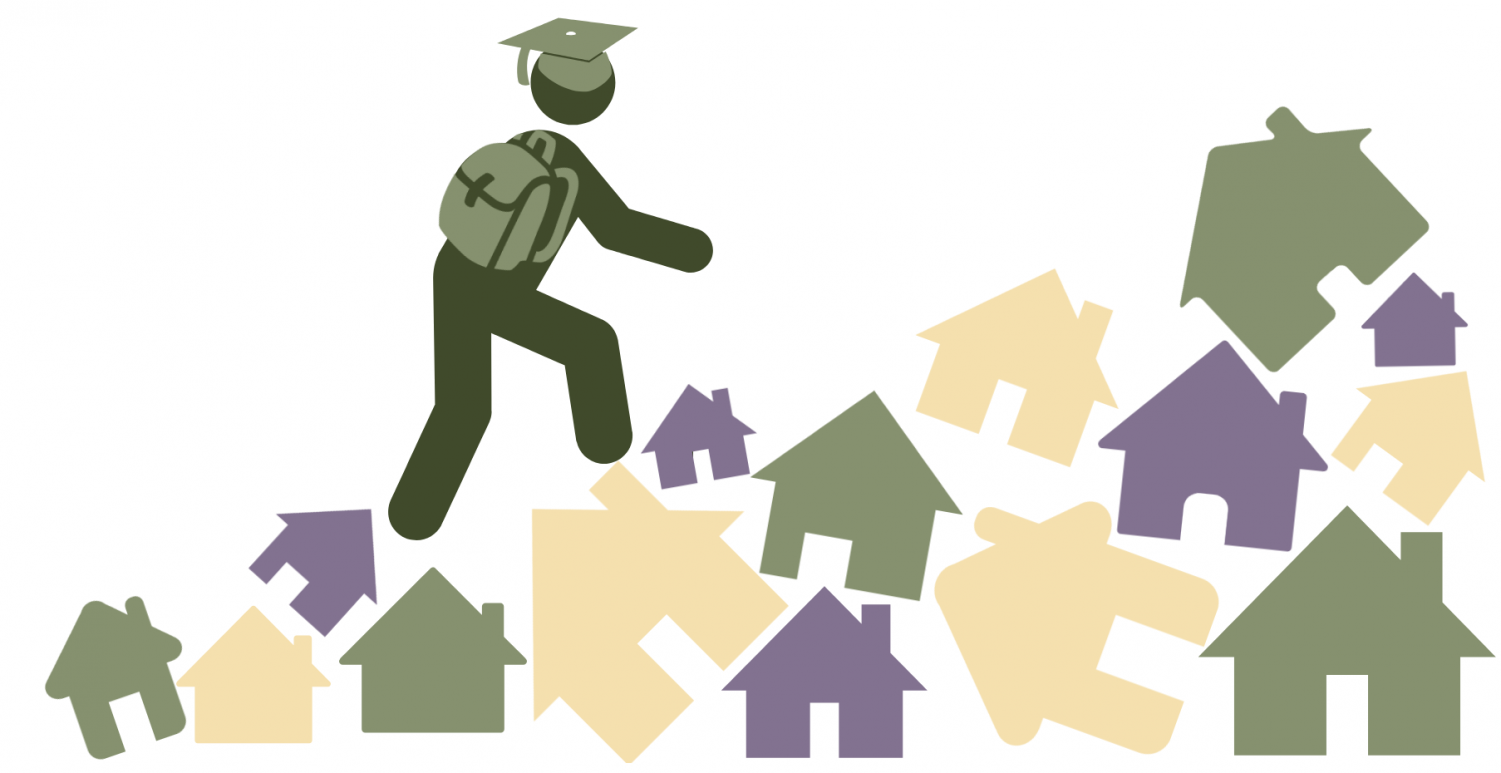Every morning at 7 a.m., Ariana Diller* begins her two-hour journey to school. However, it’s not the anticipation of a test or build-up of homework that occupies her mind on the way there.
It’s the apprehension of returning home.
Diller is a part of the foster care system and faces struggles that are uncommon for others her age. She lives in a group home with four other girls, all of whom have been subjected to various forms of neglect and abuse.
Like many in the system, her journey has been filled with painful complications.
After enduring a damaging home life for the majority of her childhood, Diller entered the foster care system at the age of 14. As she switched from home to home during her freshman year of high school, she struggled to adjust to her new life.
“It was difficult to go from being in a home with my parents to dealing with changing living circumstances and being surrounded by strangers,” Diller said.
Eventually, she settled into her current group home. Although she entered the system in order to escape an unsafe living situation, she continues to face dangerous circumstances within her current residence.
“I have to deal with high-stress situations where I live. Whether that means involving drugs, weapons, or someone that isn’t in the right state of mind, it can be really traumatic. These situations can make me either sad or angry, which can prevent me from focusing on school and functioning,” Diller said.
Tensions within her group home and a hectic daily schedule also make it difficult to find the time and a safe space to study.
“A lot of times, I have to do my homework in the car because I go from school to wrestling, which ends at 6 p.m.. By the time I get home, it’s around 8 p.m. and I have to be in bed by 9 p.m.,” Diller said. “It’s hard to figure out how to cram homework into my schedule.”
Despite this, Diller has often said she is “lucky” when she compares herself to many foster care students she has met. When someone officially enters the foster care system, they are protected by specific laws that vary based on their situation and location. Such requirements include the right to be protected from mistreatment in their placement homes.
Additionally, according to the California Education Code, Diller has the right to attend her school of origin, even though she lives almost two hours away.
Remaining in her current high school is essential to Diller because it offers her a safe and familiar space that is otherwise difficult to find.
To provide Diller with transportation, the costs to drive her to and from school are divided between districts; her origin school district pays for half the total cost of transportation while the school district where her current group home is located pays for the other half, in accordance with her Individualized Education Program (IEP).
“I have a strong case for why I should remain in my school district, and I have an IEP to do that. A lot of people that move can no longer attend their school of origin,” Diller said.
Diller’s IEP also gives her more time on tests and assignments and provides her with weekly therapy sessions. Along with her plan, the foster care system offers Diller and other foster care students additional aspects of support.
“I get housing, medical care, and when I turn 18, I get certain other benefits,” Diller said.
Such benefits include AB12, which is a program that allows foster youth to remain in care and receive housing assistance. According to Edward Manio, a program manager for the Foster Youth ILP & Workforce Services, those who are 18 and older in the AB12 program receive a monthly check of around $900.
Despite these benefits, foster care students continue to face educational disadvantages. While they do not lack ambition, studies consistently demonstrate that these students’ unique challenges limits their academic success.
According to a factsheet by the National Working Group on Foster Care and Education, “There is overwhelming evidence that children and youth in care are a vulnerable population in our public education system. The achievement gap between youth in care and the general population is staggering, with youth in care trailing their peers in standardized test performance, high school graduation rates, and the likelihood of attaining post-secondary education.”
Mark Courtney, a professor at the School of Social Service Administration and an expert on outcomes for children in foster care, said that students in foster care who try to pursue college and are behind academically are far more likely to drop out.
“Those kinds of educational challenges need to be addressed prior to entering college, or you’re going to have a hard time in college,” Courtney said.
Foster care students are often forced to switch schools, resulting in additional educational complications and a demanding adjustment process.
Manio said, “Other factors contribute to getting a good education, such as housing and transportation. For any foster youth, this can be the biggest challenge, not just for school but for life.”
For many foster care students, including Diller, the aid offered to them within the system fails to fully compensate for the obstacles they face.
“Even though I am offered services that are supposed to help me, I’m not told how to access these services. It’s always some sort of battle trying to figure out how to get the things I need to succeed,” Diller said.
Along with facing educational obstacles, foster care students are often weighed down by their past traumas. Diller herself lived through years of repeated physical, emotional, and verbal abuse before she entered the system. While this puts a toll on her mental health, she still manages to maintain healthy relationships with her friends and peers.
“Ariana and I are close. She can be mean sometimes, but that is just because her inner thoughts can take over. A lot of times, it’s just past anger that has been built up, but I understand that, and I never blame her for it,” said Sophie Walsh*, Diller’s current roommate.
Like Diller, most youths in foster care have missed out on a stable household environment during the first stages of their lives. Extensive studies prove how the lack of such an environment and trauma experienced during their youth can lead to detrimental effects on the development of their brains.
A study conducted by the Simmons College School of Social Work analyzed the effects of abuse within young adults. According to the study, those abused faced a significantly higher amount of difficulties in functioning compared to their unabused peers. Such impairments ranged from minor anxiety to suicide attempts.
For Diller, her difficult home life often clashes with stress from school and can result in challenges with her mental states. Adris Beasley, a shelter care counselor at Diller’s previous receiving home, recognized these difficulties that Diller and other foster youth continuously face.
Facts Post
null
“Along with trauma, another major obstacle I have encountered is drug dependency and severe mental health issues. These two issues pose a distinct set of barriers. It’s more challenging to make connections needed for kids to start making changes they need for healthy development,” Beasley said.
Beasley quickly formed a strong relationship with Diller.
“Ariana was pretty tricky in the beginning, but in the context of the type of trauma and abuse she was dealing with, I could relate to her situation. I would say my relationship with Ariana is a special one. I have a lot of love for that kiddo,” Beasley said.
Luckily, people like Beasley have contributed to Diller’s growing support system as she continues to work through her challenges. Her previous Court Appointed Special Advocate (CASA), Francesca Jayne, created a strong personal relationship with Diller from the beginning and continues to help her in many ways. As a former CASA volunteer, Jayne’s role was to support children in finding a safe environment in the foster care system.
“Ariana is a friend to me now that my duty as a CASA has come to an end. I would do anything for her,” Jayne said.
Diller’s friends also play an essential role in her life. While certain adults and staff workers help her with the challenges she faces in the system, Diller’s friends are there for her to rely on while she is in school.
“I have a good support system; my friends are always there to talk to, encouraging me to do the right thing,” Diller said.
Likewise, her friend group has supported her throughout these past few years and continues to do so.
“Ariana and I have been friends since kindergarten. We’ve both supported each other throughout our lives, and we could always relate to each other. Watching her go through these situations and come out stronger motivates me every day,” said Hannah Mackay*, one of Diller’s close friends.
Even in her group home, she quickly established tight bonds with people that live with her.
“She’s kind of like an older sister to me. It’s nice feeling like I have some sort of a family now, and feeling like people actually care about me,” Walsh said.
For both Walsh and Diller, being in the foster care system made them recognize that other people have gone through similar experiences that they have.
“Now, I know that I’m not alone and that I’m not the only person who went through the abuse that I did,” Diller said.
Untitled infographic by Isabelle Nunes – Infogram
null
Along with her support system, Diller’s determination challenges the disadvantages she faces as a result of being a foster care student. She continues to strive for good grades and looks forward to a bright future.
“Ariana is capable of whatever she puts her mind to, and she is the most amazing young woman I have met in some time. I feel she has gotten stronger and more self-aware as I have gotten to know her. I’m extremely proud of her, and I know that she will do great things,” Jayne said.
Once Diller entered the system, her perspective of others and life itself took a turn as she began a newfound appreciation for everything she has.
“Being in the system made me more of a go-getter towards my goals. It made me more okay with myself and more okay with other people. It made me aware of people’s situations and what we don’t know about them, and offered me a look into the often ignored aspects of society,” Diller said.
*Due to the sensitive nature of the content, this name has been changed to protect the anonymity of the source.




